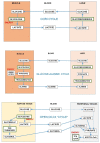Dietary Energy Partition: The Central Role of Glucose
- PMID: 33086579
- PMCID: PMC7593952
- DOI: 10.3390/ijms21207729
Dietary Energy Partition: The Central Role of Glucose
Abstract
Humans have developed effective survival mechanisms under conditions of nutrient (and energy) scarcity. Nevertheless, today, most humans face a quite different situation: excess of nutrients, especially those high in amino-nitrogen and energy (largely fat). The lack of mechanisms to prevent energy overload and the effective persistence of the mechanisms hoarding key nutrients such as amino acids has resulted in deep disorders of substrate handling. There is too often a massive untreatable accumulation of body fat in the presence of severe metabolic disorders of energy utilization and disposal, which become chronic and go much beyond the most obvious problems: diabetes, circulatory, renal and nervous disorders included loosely within the metabolic syndrome. We lack basic knowledge on diet nutrient dynamics at the tissue-cell metabolism level, and this adds to widely used medical procedures lacking sufficient scientific support, with limited or nil success. In the present longitudinal analysis of the fate of dietary nutrients, we have focused on glucose as an example of a largely unknown entity. Even most studies on hyper-energetic diets or their later consequences tend to ignore the critical role of carbohydrate (and nitrogen disposal) as (probably) the two main factors affecting the substrate partition and metabolism.
Keywords: body energy interchanges; diet; dietary protein as energy substrate; disposal of excess nitrogen; energy metabolism; energy storage; glucose; handling of dietary lipids; inter-organ energy relationships.
Conflict of interest statement
The Authors declare no conflict of interest.
Figures











Similar articles
-
Utilization of dietary glucose in the metabolic syndrome.Nutr Metab (Lond). 2011 Oct 26;8(1):74. doi: 10.1186/1743-7075-8-74. Nutr Metab (Lond). 2011. PMID: 22029632 Free PMC article.
-
Endogenous and dietary lipids influencing feed intake and energy metabolism of periparturient dairy cows.Domest Anim Endocrinol. 2016 Jul;56 Suppl:S2-S10. doi: 10.1016/j.domaniend.2015.12.002. Domest Anim Endocrinol. 2016. PMID: 27345317 Review.
-
Dietary Carbohydrate as Glycemic Load, Not Fat, Coupled with Genetic Permissiveness Favoring Rapid Growth and Extra Calories, Dictate Metabolic Syndrome and Diabetes Induction in Nile Rats (Arvicanthis niloticus).Nutrients. 2022 Jul 26;14(15):3064. doi: 10.3390/nu14153064. Nutrients. 2022. PMID: 35893924 Free PMC article.
-
Studies on the nutrition of marine flatfish. The metabolism of glucose by plaice (Pleuronectes platessa) and the effect of dietary energy source on protein utilization in plaice.Br J Nutr. 1975 Mar;33(2):219-31. doi: 10.1079/bjn19750026. Br J Nutr. 1975. PMID: 1115761
-
Comments on metabolic needs for glucose and the role of gluconeogenesis.Eur J Clin Nutr. 1999 Apr;53 Suppl 1:S107-11. doi: 10.1038/sj.ejcn.1600748. Eur J Clin Nutr. 1999. PMID: 10365987 Review.
Cited by
-
Serum glucose/potassium ratio as an indicator of early and delayed outcomes of acute carbon monoxide poisoning.Toxicol Res (Camb). 2024 Oct 7;13(5):tfae168. doi: 10.1093/toxres/tfae168. eCollection 2024 Oct. Toxicol Res (Camb). 2024. PMID: 39381599
-
The Metabolic Syndrome, a Human Disease.Int J Mol Sci. 2024 Feb 13;25(4):2251. doi: 10.3390/ijms25042251. Int J Mol Sci. 2024. PMID: 38396928 Free PMC article. Review.
-
Tryptophanylation of insulin receptor by WARS attenuates insulin signaling.Cell Mol Life Sci. 2024 Jan 12;81(1):25. doi: 10.1007/s00018-023-05082-2. Cell Mol Life Sci. 2024. PMID: 38212570 Free PMC article.
-
The Roles of Androgens in Humans: Biology, Metabolic Regulation and Health.Int J Mol Sci. 2022 Oct 8;23(19):11952. doi: 10.3390/ijms231911952. Int J Mol Sci. 2022. PMID: 36233256 Free PMC article. Review.
-
Estrogens and the regulation of glucose metabolism.World J Diabetes. 2021 Oct 15;12(10):1622-1654. doi: 10.4239/wjd.v12.i10.1622. World J Diabetes. 2021. PMID: 34754368 Free PMC article. Review.
References
-
- Garfield E. Trends in biochemical literature. Trends Biochem. Sci. 1979;4:N290. doi: 10.1016/0968-0004(79)90288-3. - DOI
-
- Sawyer A. South, north, east and western: The story of how the western blot came into being. BioTechniques. Jul 18, 2018.

